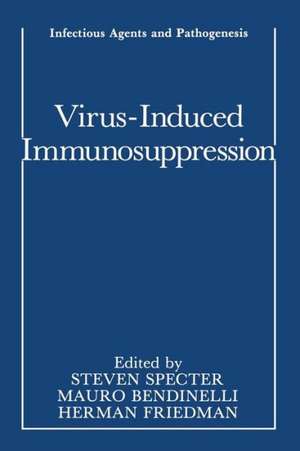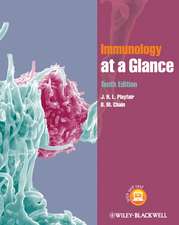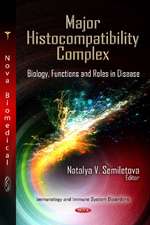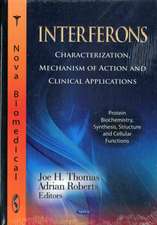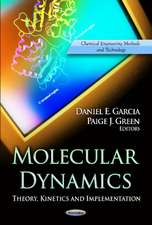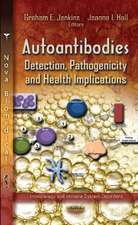Virus-Induced Immunosuppression: Infectious Agents and Pathogenesis
Editat de Steven Specter, Mauro Bendinelli, Herman Friedmanen Limba Engleză Paperback – 30 mar 2012
Din seria Infectious Agents and Pathogenesis
- 5%
 Preț: 1417.17 lei
Preț: 1417.17 lei - 5%
 Preț: 1099.73 lei
Preț: 1099.73 lei - 18%
 Preț: 1221.20 lei
Preț: 1221.20 lei - 5%
 Preț: 1426.90 lei
Preț: 1426.90 lei - 5%
 Preț: 1103.03 lei
Preț: 1103.03 lei - 5%
 Preț: 1412.79 lei
Preț: 1412.79 lei - 5%
 Preț: 1110.17 lei
Preț: 1110.17 lei - 18%
 Preț: 953.65 lei
Preț: 953.65 lei - 5%
 Preț: 1434.91 lei
Preț: 1434.91 lei - 5%
 Preț: 1611.40 lei
Preț: 1611.40 lei - 18%
 Preț: 946.55 lei
Preț: 946.55 lei - 18%
 Preț: 947.35 lei
Preț: 947.35 lei - 5%
 Preț: 1606.80 lei
Preț: 1606.80 lei - 5%
 Preț: 1096.45 lei
Preț: 1096.45 lei - 18%
 Preț: 947.04 lei
Preț: 947.04 lei - 5%
 Preț: 375.70 lei
Preț: 375.70 lei - 5%
 Preț: 723.05 lei
Preț: 723.05 lei - 5%
 Preț: 372.19 lei
Preț: 372.19 lei - 5%
 Preț: 1099.56 lei
Preț: 1099.56 lei - 5%
 Preț: 369.84 lei
Preț: 369.84 lei - 5%
 Preț: 369.45 lei
Preț: 369.45 lei - 5%
 Preț: 393.79 lei
Preț: 393.79 lei
Preț: 378.60 lei
Preț vechi: 398.53 lei
-5% Nou
Puncte Express: 568
Preț estimativ în valută:
72.44€ • 75.64$ • 59.82£
72.44€ • 75.64$ • 59.82£
Carte tipărită la comandă
Livrare economică 15-29 aprilie
Preluare comenzi: 021 569.72.76
Specificații
ISBN-13: 9781468455854
ISBN-10: 1468455850
Pagini: 500
Ilustrații: 500 p.
Dimensiuni: 152 x 229 x 26 mm
Greutate: 0.66 kg
Ediția:Softcover reprint of the original 1st ed. 1989
Editura: Springer Us
Colecția Springer
Seria Infectious Agents and Pathogenesis
Locul publicării:New York, NY, United States
ISBN-10: 1468455850
Pagini: 500
Ilustrații: 500 p.
Dimensiuni: 152 x 229 x 26 mm
Greutate: 0.66 kg
Ediția:Softcover reprint of the original 1st ed. 1989
Editura: Springer Us
Colecția Springer
Seria Infectious Agents and Pathogenesis
Locul publicării:New York, NY, United States
Public țintă
Professional/practitionerCuprins
1. Viruses and Immunosuppression: General Comments.- 1. History.- 2. Antiviral Defenses.- 2.1. Antibodies.- 2.2. Cellular Immunity.- 2.3. Nonspecific Soluble Factors.- 3. Mechanisms of Immune Suppression by Viruses.- 3.1. Infection of Lymphoid Cells.- 3.2. Activation of Suppressor Cells.- 3.3. Suppressor Factors.- 3.4. Other Mechanisms Effecting Virus-Induced Immune Suppression.- 4. Factors That Might Influence Virus-Induced Immune Suppression.- 4.1. Age.- 4.2. Genetics.- 4.3. Presence of Other Infections and Diseases.- 4.4. Environment.- 5. Virus-Specific versus Generalized Immunosuppression.- 6. How Immunosuppression Can Affect Pathogenesis.- References.- 2. Immunomodulation by Hepatitis B and Related Viruses.- 1. Introduction.- 2. Basic Properties of Human Hepatitis B and Related Viruses.- 3. Immunopathologic Sequelae of Hepatitis B Virus Infection.- 4. Interaction of Hepatitis B Virus with the Immune System.- 4.1. Antibody Production.- 4.2. T Lymphocytes.- 4.3. Macrophages.- 4.4. Natural Killer Cells.- 4.5. Soluble Factors.- 5. Significance of Hepatitis B Virus-Induced Immunomodulation in Pathogenesis.- References.- 3. Papovaviruses.- 1. General Characteristics of the Viruses.- 2. Interactions with the Immune System.- 2.1. Papillomaviruses.- 2.2. Polyomaviruses.- 3. Conclusion.- References.- 4. Adenoviruses.- 1. Adenoviruses: Basic Properties.- 2. Immune Responses to Adenovirus.- 2.1. Antibody Responses to Natural Infection in the Normal Host.- 2.2. Humoral and Local Antibody Responses to AdenovirusVaccines.- 2.3. Natural Infection in the ImmunosuppressedHost: Clinical Aspects.- 3. Immunosuppressive Effects of Adenoviruses.- 3.1. Modulation of T-Cell Number and Function.- 3.2. Modulation of Macrophage Function.- 3.3. Modulation of NK Cells and/or ADCC.- 3.4. Modulation of Soluble Factors.- 3.5. Suppression of Antibody Production.- 4. Viral Replication within the Immune System.- 5. Significance.- References.- 5. Herpes Simple.- 1. Introduction.- 2. Basic Properties.- 2.1. Virion Structure.- 2.2. Replicative Cycle.- 3. Modulation of Immune Responses by Herpesvirus.- 3.1. Antibody Production.- 3.2. T Lymphocytes.- 3.3. Macrophages.- 3.4. NK Cells.- 3.5. Other Cells.- 3.6. Soluble Factors.- 4. Mechanism(s) of Immunosuppression.- 5. Immunomodulation and Pathogenesis.- 5.1. Immunity and the Establishment/Maintenance of Latency.- 5.2. Immunity and Recurrent Disease.- References.- 6. Human Cytomegalovirus.- 1. Introduction.- 1.1. Type Strains of Human Cytomegalovirus.- 1.2. Properties of the Virus.- 2. Infection.- 2.1. Congenital.- 2.2. Perinatal.- 2.3. HCMV Mononucleosis.- 2.4. Immunocompromised Hosts.- 3. Antigens of HCMV.- 3.1. Physical and Biochemical Analysis.- 3.2. Immunologic Analysis.- 4. Host Antibody Response against HCMV.- 4.1. Complement-Fixing Antibodies.- 4.2. IgG Subclasses.- 4.3. Immunoprecipitation—Immunoblot Analysis.- 4.4. Secretory IgA.- 4.5. IgE Antibody.- 4.6. Neutralizing Antibody.- 4.7. Immune Complexes.- 4.8. Cytolytic Antibody.- 5. Lymphocyte Blastogenic Response.- 6. Natural Killer Cell Activity.- 6.1. In Vitro Assay.- 6.2. Clinical Studies.- 6.3. Genetic Influence on the Murine NK-Cell Response.- 7. Antibody-Dependent Cell-Mediated Cytotoxicity.- 8. HLA-Restricted Cytotoxic T-Cell Activity.- 9. Interaction of HCMV with Leukocytes.- 9.1. T-Cell Subset Ratios.- 9.2. HCMV Infection of Leukocytes.- 9.3. Immune Suppression in HCMV Mononucleosis.- 10. Perspective.- References.- 7. Epstein — Barr Virus-Induced Immune Deficiency.- 1. Introduction.- 2. Properties of Epstein-Barr Virus.- 3. Modulation of Immunity byEBV.- 3.1. Antibody Production during Acute EBV Infection.- 3.2. T-Lymphocyte Function during Acute Infectious Mononucleosis.- 4. Other Mechanisms of EBV-Induced mmunosuppression.- 5. Clinical Significance of EBV-Induced Immunomodulation in Viral Pathogenesis of Diseases in Males with XLP.- 6. Summary.- References.- 8. Immunosuppression by Bovine Herpesvirus 1 and Other Selected Herpesviruses.- 1. Introduction.- 2. Bovine Herpesvirus.- 2.1. Virology.- 2.2. Immunology.- 2.3. Immunosuppression.- 2.4. Summary.- 3. Other Herpesviruses.- 3.1. Equine Herpesviruses.- 3.2. Pseudorabies Virus.- 3.3. Avian Herpesviruses.- 3.4. Rodent Herpesviruses.- 3.5. Varicella Zoster.- References.- 9. Poxviruses.- 1. Introduction.- 2. Properties of Poxviruses.- 2.1. Physical Characteristics.- 2.2. Genetics.- 2.3. Classification.- 2.4. Host Range.- 2.5. Tumor Formation.- 3. Effects of Poxviruses on Immune Function.- 3.1. Smallpox.- 3.2. Vaccinia.- 3.3. Leporipoxviruses.- 3.4. Effects on the Immune System of Malignant Rabbit Fibroma Virus.- 3.5. Malignant Rabbit Fibroma Virus Replication within the Cells of the Immune System.- 4. Role of Immunosuppression in the Pathogenesis of Poxvirus Infection.- 4.1. Orthopoxviruses.- 4.2. Leporipoxviruses.- References.- 10. Reovirus-Induced Immunosuppression.- 1. Introduction.- 1.1. Basic Properties of Reoviruses.- 1.2. Clinical Manifestations Associated with Reovirus Infections.- 2. Modulation of Immunity by Reoviruses.- 2.1. Interaction of Reoviruses with Cells of the Immune System.- 2.2. Suppression of Immune Responsiveness by Reoviruses.- 3. Significance of Virus-Induced Immunomodulation in Viral Pathogenesis.- References.- 11. Immunosuppression by Avian Infectious Bursal Disease Virus and Mouse Heptatitis Virus.- 1. Introduction.- 2.Immunosuppression by Avian Infectious Bursal Disease Virus.- 2.1. A Characterization of the Virus and the Disease.- 2.2. Influence on Circulating B and T Lymphocytes.- 2.3. Influence on Antibody Production.- 2.4. Influence on Cellular Immune Functions.- 2.5. Influence on Soluble Immune Factors.- 2.6. Mechanism of Immunosuppression.- 3. Immunosuppression by Mouse Hepatitis Virus.- 3.1. Biology of the Virus.- 3.2. Pathogenesis of Mouse Coronaviruses.- 3.3. MHV3-Induced Immunosuppression.- 3.4. Immune Functions of MHV3-Infected Mice.- 3.5. Mechanism of Immunosuppression.- 4. Summary.- References.- 12. Picornavirus-Induced Immunosuppression.- 1. Introduction.- 1.1. Basic Properties of Picornaviruses.- 1.2. Clinical Manifestations Associated with Picornavirus Infections.- 2. Modulation of Immunity by Picornaviruses.- 2.1. Antibody Production.- 2.2. Lymphocytes.- 2.3. Phagocytic Cells.- 2.4. Interferon System.- 3. Experimental Infection of Mice with Coxsackievirus B-3.- 4. Mechanisms of Immunosuppression.- 5. Significance of Virus-Induced Immunomodulation in Viral Pathogenesis.- References.- 13. Arenaviruses.- 1. Introduction.- 2. Basic Properties of the Viruses.- 2.1. Morphology.- 2.2. Biochemical Properties.- 2.3. Pathogenesis.- 3. Modulation of Immunity.- 3.1. Antibody Production.- 3.2. T Lymphocytes.- 3.3. Macrophages.- 3.4. Natural Killer Cells and Soluble Factors.- 4. Mechanisms of Viral Suppression.- 5. Significance of Virus-Induced Modulation in ViralPathogenesis.- References.- 14. Togavirus-Induced Immunosuppression.- 1. Introduction.- 2. Basic Properties of the Viruses.- 3. Antigenic Relationships.- 4. Host-Defense Mechanisms.- 4.1. Antibodies.- 4.2. Cell-Mediated Immune Response.- 5. Interactions with Cells of the Immune System.- 5.1. Lymphoid Tissues.- 5.2. BloodLeukocytes.- 5.3. Macrophages.- 5.4. Soluble Factors.- 6. Suppression of Immune Responses.- 6.1. Immunosuppression by Togaviruses.- 6.2. Immunosuppression by Rubella Virus.- 6.3. Immunosuppression by LDV.- 6.4. Immunosuppression by Dengue Virus.- 7. Adverse Effects of Immunosuppression.- 8. Conclusion.- References.- 15. Rhabdoviruses: Effect of Vesicular Stomatitis Virus Infection on the Development and Regulation of Cell-Mediated and Humoral Immune Responses.- 1. Basic Properties of Vesicular Stomatitis Virus.- 2. Modulation of Host-Immune Responses by Vesicular Stomatitis Virus.- 2.1. Introduction.- 2.2. Interferon and Anti-VSV Activity.- 2.3. Effect of VSV Infection on Macrophage Activation.- 2.4. Effect of VSV Infection on T- and B-Cell-Mediated Immune Response in Vivo.- 2.5. Effect of VSV Infection in Vitro.- References.- 16. Virus-Induced Immunosuppression: Influenza Virus.- 1. Introduction.- 2. Basic Properties of the Virus.- 3. Modulation of Immunity by the Virus.- 3.1. Antibody Production.- 3.2. T Lymphocytes.- 3.3. Macrophages.- 3.4. Natural Killer Cells and ADCC.- 3.5. Miscellaneous Cells.- 3.6. Soluble Factors.- 4. Mechanisms of Immunosuppression.- 4.1. Viral Replication within the Immune System.- 4.2. Potentially Immunosuppressive Virus-Induced Host Responses.- 5. Significance of Virus-Induced Immunomodulation in Viral Pathogenesis.- 5.1. Immunologic Participation in Observed Pathology.- 5.2. Genetic Contributions.- 5.3. Immunofocusing and the Selectivity of Immunomodulation.- References.- 17. Paramyxoviruses.- 1. Basic Properties of Viruses.- 1.1. Classification.- 1.2. Molecular Structure.- 1.3. Replication of Paramyxoviruses.- 2. Modulation of Immunity by the Viruses.- 2.1. Parainfluenza and Respiratory Syncytial Viruses.- 2.2. Mumps Virus.- 3. Immune Reactivity and Paramyxoviruses.- 4. Immunopathogenesis.- 5. Mechanisms of Immunosuppression.- References.- 18. Immunosuppression by Measles Virus.- 1. Introduction.- 1.1. Characteristics and Basic Properties of Measles Virus.- 1.2. Human Pathology Associated with Measles Virus Infection.- 2. Modulation of Adaptive (Immune) and Nonadaptive (Natural) Responses by Measles Virus.- 2.1. Infection of Human Leukocytes by Measles Virus.- 2.2. Modulation of Antibody Production by Measles Virus.- 2.3. Modulation of Function of Amplifying T cell and Effector T Cell by Measles Virus.- 2.4. Modulation of Natural Killer Cell Activity by Measles Virus.- 3. Mechanisms of Immunosuppression and Significance of Virus-Induced Immunosuppression in Viral Pathogenesis.- References.- 19. Avian Retroviruses.- 1. Basic Properties of the Viruses.- 1.1. Avian Sarcoma—Leukosis Complex.- 1.2. Reticuloendotheliosis Viruses.- 2. Modulation of the Immune Response.- 2.1. Humoral Responses.- 2.2. Cellular Responses.- 3. Mechanisms of Immunosuppression.- 4. Significance of Immunomodulation in Viral Pathogenesis.- References.- 20. Nonhuman Mammalian Retroviruses.- 1. Basic Properties.- 2. Modulation of Immunity by Retroviruses.- 2.1. Introduction.- 2.2. Murine Leukemia/Sarcoma Viruses.- 2.3. Feline Retroviruses.- 2.4. Bovine Retroviruses.- 2.5. Ovine/Caprine Retroviruses.- 2.6. Equine Retroviruses.- 2.7. Nonhuman Primate Retroviruses.- 3. Mechanisms of Immunosuppression.- 3.1. General.- 3.2. Viral Replication within Cells of the Immune System.- 3.3. Virion-Associated Immunosuppressive Products.- 3.4. Suppressor Cells.- 3.5. Role of Nonviral Soluble Factors.- 4. Significance of Virus-Induced Immunosuppression.- 5. Conclusions.- References.- 21. Implications for Immunotherapy of Viral Infections.- 1.Introduction.- 2. Immunostimulatory Agents.- 2.1. Bacteria and Their Products as Immunomodulators.- 2.2. Products of the Immune System.- 2.3. Antiviral Immunostimulatory Drugs.- 3. Conclusions.- References.- 22. Conclusions and Prospects.- 1. Phenomenology.- 2. Pathophysiology.- 3. Biologic Significance.- 4. Effects on the Evolution of the Inducing Infection.- 5. Effects on Pathogenesis by the Inducing Virus.- 6. Effects on Resistance to Other Infections.- 7. Effects on Resistance to Tumors.- 8. Implications for Therapy of Viral Infections.- 9. Possible Role of Viruses in the Genesis of Idiopathic Immune Deficiencies.- References.
